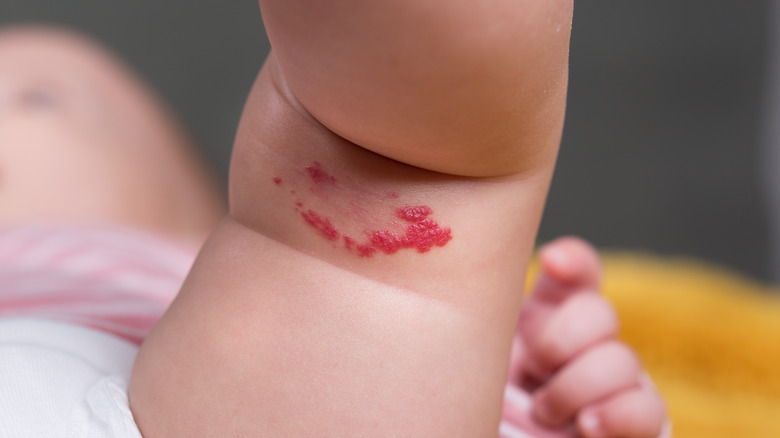This Is When A Birthmark Should Worry You
If your baby was born with a birthmark, in most cases you should have little cause for worry, since most of these are quite harmless and won't require any treatment at all. Nationwide Children's Hospital says that over 80 percent of all newborns have some type of birthmark, which is defined as a colored spot on the skin that can appear in shades of brown, black, blue, or red, and may range in size from a tiny freckle to a discoloration that can cover a large area of the child's body.
Birthmarks can be classified as either vascular, which are caused by blood vessels, or non-vascular, which are marks caused by skin pigmentation.
Problems with vascular birthmarks
The most common type of vascular birthmark is a flat, pink, blotchy area called a macular stain or "angel's kiss," but these marks tend to be harmless and often fade before the child turns 2. Port-wine stains, however, are larger pink or red patches that grow with the child, and will not go away on their own.
Large facial port-wine stains may indicate the potential for an infant to experience eye problems, seizures, or developmental delays later in life, but in most cases, the worst problem they present is that of potential embarrassment for the child as they grow up. For that reason, many parents choose to have a port-wine birthmark removed when the child is very young, as was the case with singer Ed Sheeran.
The worst types of vascular birthmarks tend to be hemangiomas or "strawberry marks" which may appear as small, but rapidly-growing, red bumps or patches. While many hemangiomas will shrink and fade by the time a child is in elementary school, they can present problems if they are bleeding or are close to the eyes where they might interfere with vision. Hemangiomas can indicate possible problems under the skin's surface, as well. Dr. Robert Sidbury, dermatology chief at Seattle Children's, told Parent Map, "Hemangiomas around the mouth, neck and chin should be looked at by a specialist, because the birthmark could be growing in and around the vocal cords inside the body."
Problems with non-vascular birthmarks
Congenital melanocytic nevi, more commonly referred to as moles, are present in about one percent of all babies. While moles are usually not problematic, they should be kept under observance, with any change in size or appearance being reported to the child's pediatrician or a pediatric dermatologist. If there is any concern at all of a mole's potential for developing into a type of skin cancer called melanoma, that mole may need to be surgically removed.
Café-au-lait spots are far more common — found in up to 50 percent of babies — and far more benign. These small, flat spots are, as the name suggests, light brown in color, and present no risk of cancer. Children with a large number of these spots, though, may need to be checked for a condition called neurofibromatosis-1, which is associated with abnormal growth of nerve tissues in the body.
The special problems of Mongolian spots
One danger of the non-medical kind is associated with a birthmark called a Mongolian spot. These patches, which range from brown to gray to blue-black in color, are located on a baby's buttocks and back and sometimes on the legs and shoulders. While they are present in the vast majority of non-Caucasian infants — over 90 percent of African-descended peoples and Native Americans, over 80 percent of Asians, and over 70 percent of Hispanics — they are found in just 10 percent of babies whose ancestry is solely European. As a result of this demographic divide, many Caucasians are not at all familiar with this type of birthmark.
Problems can arise when Mongolian spots, due to their coloring and location on a child's body, are mistaken for bruises. Dr. Alan Greene discusses in his wellness blog a case where a child was removed from her parents by the authorities and child abuse charges were being considered, only to be dropped when the "bruises" were correctly diagnosed as Mongolian spots. Judging from the comments on the blog, this is hardly an isolated case, as other parents related stories of their own problems with child protective services misinterpreting Mongolian spots as bruising. Apart from such cases of mistaken identity, however, there is no harm to the child from the Mongolian spots themselves. These spots don't tend to be permanent, with 95 percent of all such discolorations fading before a child reaches adulthood.



